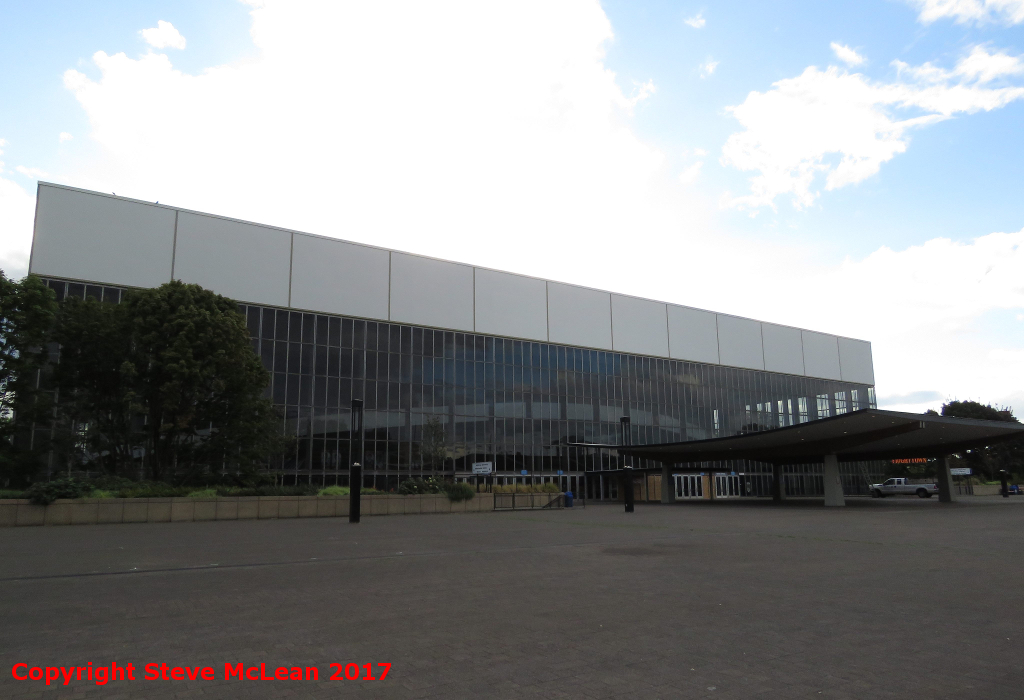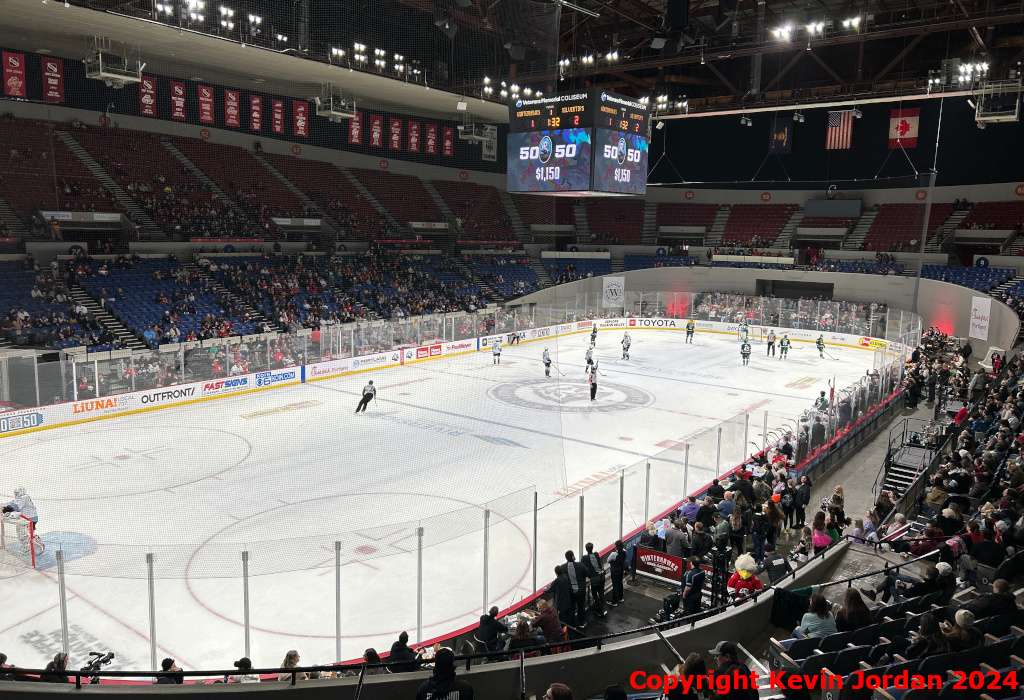
Portland Winterhawks
Arena Name: Veterans Memorial Coliseum
Capacity: 12,888
Built: 1960
Address: 300 N. Winning Way, Portland, OR 97227
Telephone: (503) 238-6366
Ice Surface Size: Regulation
Franchise Date: 1976-77
WHL Championships: 3, in 1982-83, 1997-98 & 2012-13
Memorial Cup Championships: 2, in 1982-83 & 1997-98
Colours: Red, White, Silver & Black
Official Web Site: Winterhawks.com
Former Arena: Rose Garden

Veterans Memorial Coliseum

What's the Arena Like?
First Visit: October 27, 2024
CHL Arena: 78
WHL Arena: 21
Hockey arenas don't exactly get a lot of respect from architecture critics. While arenas are often the largest indoor public building in any city, their architecture tends to be utilitarian, and for the most part, they aren't the kind of places that get glowing reviews in architectural journals.
Portland's Veterans Memorial Coliseum is one of the rare arenas that bucks that trend. Built in 1960, the arena was designed by Skidmore, Owings & Merrill and is an icon of the International Style of architecture, to the point it has been listed on the U.S. National Register of Historic Places. Where arenas up to the Coliseum tended to be dark inside, the Coliseum made use of natural light in a way that no arena before, and few after, were ever able to. The building essentially is a glass box; four non-load bearing glass walls built around an open-topped indoor stadium surrounding the ice, so that on the inside, natural light makes it into the bowl on all four sides.
I had wanted to come to the Coliseum dating back to at least the 1990's, when I first learned about Portland's glass masterpiece, but it took me until the fall of 2024 - and CHL 59/60 - to finally make the trip. And unlike so many things over the years that you've been hyped about and ultimately fall short of expectations, the Coliseum, if anything, surpassed them. It was incredible.
The Coliseum is just north of Portland's downtown, immediately adjacent to its replacement as a home to the NBA, the Rose Garden. There's a light rail stop just outside the door, so access is easy. The day I was there, the Trail Blazers were playing at the same time, so I assume parking would have been a disaster, but parking and riding on transit was ultimately simple and efficient.
The Coliseum lies fronting a plaza with a large overhang marking the main entrance. The glass walls are the building's dominant architectural cue, and with everything lit up inside, you can easily see indoors from the outside. Once inside, you find yourself in a concourse bathed in natural light for a day game, which ours was. The glass walls are huge, towering overhead, and your eyes are immediately drawn to the outside, whether it be a view of the outside plaza, the Rose Garden, or downtown Portland just across the river.
The building is designed more or less as two separate and unrelated structures. The seating bowl towers over the concourse, but there's no connection between it and the outside walls, and in fact if one were to remove the glass box, the Coliseum bowl could easily serve as an outdoor rink. For most games, a set of curtains cuts off outside light from entering the bowl, and in fact each portal entry to the Coliseum is closed off by doors that remain shut during play, as I'd assume that much direct sunlight on the ice wouldn't be helpful. The concourse itself is well-used, with team history on display everywhere, a huge team souvenir kiosk, and concessions, but there's also a ton of open space where you can just wander and take in the light streaming through the glass walls. Best of all, the building is remarkably unchanged from when it opened, so arena signage, lighting, etc. is all the original mid-century modern. There has never been a tasteless modernizing renovation done here; it's still 1960 here in so many ways.
Once entering the seating bowl, you find an ice rink surrounded by a circular bowl of seats, laid out all on one level with a mid-way concourse halfway up the bowl. The Coliseum wasn't designed originally for hockey - or for any sport, for that matter - so on the sides the seats angle in a circle high up into the rafters, whereas in the ends the seats angle down quite significantly. They're all originals from 1960, red above the halfway point and blue below. At the top of the seating sections, and as a result of the odd circular seating arrangement, there are occasionally bench seats, some of which angle in towards the row in front at crazy angles. The team's multiple banners from decades of success hang from the rafters, as well as the Portland Buckaroos' championship banners from the old professional WHL.
If the arena itself had been the only selling point I still would have loved Portland unconditionally, but inside the stands themselves, the fan base was absolutely terrific. Crowd noise was decent even for the small, early-season crowd we had, and numerous people made themselves known on Twitter and in person and wanted to come up to talk to us. I've had the warm road game welcome many times before in junior hockey, but it's rare to have it for a game in so large a city.
My only real criticisms of the Coliseum are minor. Music occasionally played during play in Portland - I've learned this is common throughout the U.S. Division of the WHL, but that doesn't mean I have to like it. Secondly, the Coliseum wasn't designed for hockey, so there are seats in the corners that have a semi-obstructed view of the ice. And finally, the unusually small centre scoreboard doesn't have a shot counter or penalties on it, so those duties are handled by old digital boards in two of the corners... but there are multiple sections that have a view of neither one. None of this is unforgiveable, but the Coliseum does have a few odd flaws as a hockey rink that takes nothing away from how incredible it is as an arena.
In case it isn't obvious already, I loved the Portland Coliseum. It stands as one of the icons of junior hockey, along with Kitchener's Aud and the Colisée in Quebec City and a few others that one hopes will last forever and never change. The fact that the Coliseum is listed on the National Register for Historic Places likely means that the building will outlive me, and I hope that it does. This is the kind of place that must be preserved forever for future generations to visit, to bask in the natural light through the glass walls, to take in a hockey game in an arena that's about as close to perfect as they come.
And someday, maybe I'll get back for the annual game where they open the curtains and let natural light into the arena bowl itself. One can only dream...
Inside Veterans Memorial Coliseum

Future Developments
Veterans Memorial Coliseum had numerous electrical, plumbing, and other behind the scenes things upgraded over the summer of 2024 as the Winterhawks plan to play another fifty odd years there. There are plans for the 2025 offseason to finally replace some of the old seats, though thankfully, with the building listed on the National Register for Historic Places, renovations must be done tactfully and in keeping with the historic character of the building.
Franchise History
The Portland Winterhawks' history dated back to 1950 as the original Edmonton Oil Kings. The team won the Memorial Cup twice in the sixties under the leadership of Bill Hunter, playing at Edmonton Gardens and Jasper Place. They moved to Portland in 1976, playing consistently at the Coliseum, but also building-sharing at the Rose Garden with the NBA's Trail Blazers between 1995 and 2020.
Retired Numbers
21 Cam Neely
Feedback
If anything is incorrect or you have something to add, please e-mail me at  and I'll update the guide.
and I'll update the guide.
 and I'll update the guide.
and I'll update the guide.Copyright © WHL Arena Guide, 2002-24.
All rights reserved.
Last Revised: October 28, 2024